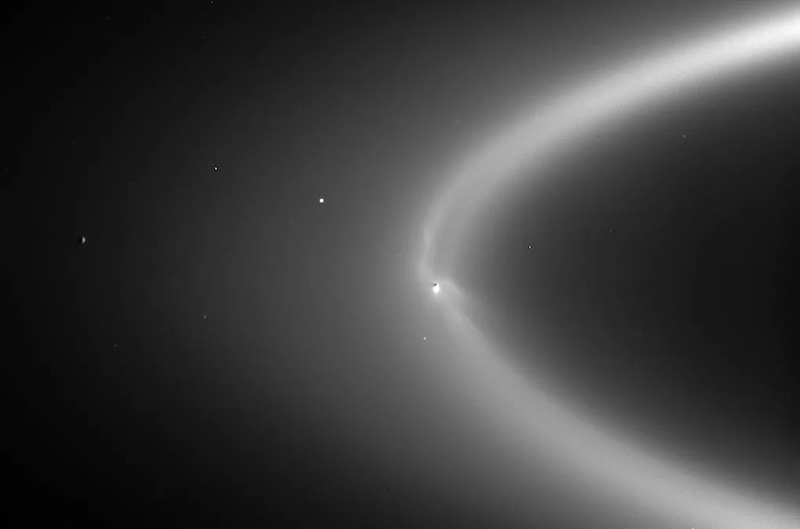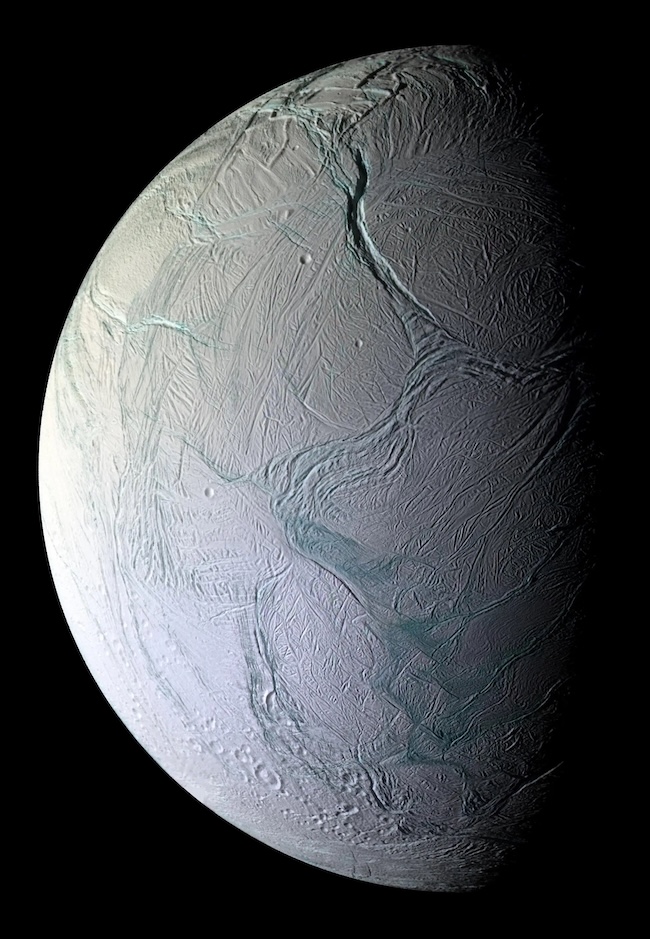- Saturn’s moon Enceladus has an ocean under its icy surface. Geyser-like plumes of water vapor erupt through cracks in the ice crust and into space.
- NASA’s Cassini spacecraft sampled the plumes as it flew through them multiple times. It found organic molecules and other evidence that the ocean is potentially habitable.
- Even more complex organics have now been identified in the plume material. Researchers in Germany found them in a new analysis of Cassini’s data.
Exciting news! Six months ago, just as we were ending our spring fundraiser, EarthSky received a $50,000 gift, with a request that it be used to collect matching funds. Whoa! We were so thrilled and grateful. And now it’s time to make good on our obligation. Please help us meet this match by donating to EarthSky today!
Intriguing new analysis of Cassini’s data
The chances for life on Saturn’s ocean moon Enceladus keep improving. Studies using data from NASA’s Cassini mission continue to show conditions in the subsurface ocean appear to be habitable, at least for microbes. On September 11, 2024, researchers in Germany at the Europlanet Science Congress said they completed a new study of organic molecules on Enceladus. They said they’ve found evidence for additional and previously unknown complex organic molecules and chemical groups. The chemical groups are common to many biological molecules, at least on Earth. It isn’t proof of life yet, but it’s another big clue supporting the possibility.
Nozair Khawaja at the Free University of Berlin in Germany, who led the study, presented the abstract. And New Scientist reported the newest findings on September 13, 2024.
Scientists have considered Enceladus as a possible candidate for life ever since Cassini showed it has a subsurface ocean. That contention has grown as ongoing studies of the Cassini’s data have revealed the ocean to be potentially habitable in multiple ways. As the abstract stated:
The search for habitable environments in the outer solar system is at the forefront of contemporary space exploration. The presence of subsurface liquid water, energy sources and organic molecules make some icy moons with subsurface oceans potential sites to search for extraterrestrial life. Among these bodies are the Jovian moon Europa and the Saturnian moons Enceladus and Titan. The recent detection of phosphorus (Postberg et al. 2023) and HCN [hydrogen cyanide] (Peter et al. 2024) in the ocean of Enceladus has further enhanced its astrobiological potential.
Complex organics on Enceladus revealed
The researchers studied data from the Cassini spacecraft. Cassini explored Saturn and its moons in unprecedented detail. It ended its mission on September 15, 2017. The spacecraft flew through the water vapor plumes on Enceladus multiple times, analyzing their composition. It also analyzed particles from the plumes that had ended up in Saturn’s E ring. Indeed, Cassini found all six of the chemical elements that life requires (at least life on Earth): carbon, hydrogen, nitrogen, oxygen, phosphorus and sulfur. It also found other simpler organic molecules in the plumes.
Now, the new study has revealed even more organic molecules and chemicals than what scientists previously knew. These include esters, alkenes and ethers, as well as other complex molecules containing nitrogen and oxygen. We don’t know yet exactly which chemical groups the organics originated from. But their presence provides evidence for possible chemical reactions that could produce fats or nucleotide bases, the building blocks of DNA. The abstract stated:
Our results confirm the presence of aryl and oxygen moieties [molecule parts] in ice grains that were previously sampled in the E ring, providing fresh insights into the stability of these compounds at Enceladean hydrothermal sites. In addition, mass spectra of these freshly ejected organic-bearing grains also exhibit certain spectral features that were not observed at lower impact speeds in the E ring. For the first time, we find ether/ethyl and ester/alkene group moieties in these plume ice grains that provide a basis for alterative pathways for organic synthesis in hydrothermal systems on Enceladus, which carries significant implications for the habitability of the Enceladus ocean.
Analyzing particles in plumes and E ring
Cassini analyzed tiny ice grains and other particles in Saturn’s E ring that originated from the water vapor plumes on Enceladus. In addition, it also directly analyzed particles in the plumes themselves. Previous studies of the Cassini data had focused mostly on the ring particles. The paper affirmed:
Enceladus ejects subsurface material into space in the form of ice grains and vapors from the moon’s south polar region. Most of the ice grains fall back onto the surface, with only a fraction of these grains escaping the moon’s Hill Sphere and forming part of Saturn’s E ring. Cassini’s on-board mass spectrometers – the Cosmic Dust Analyzer (CDA) and Ion and Neutral Mass Spectrometer (INMS) – sampled gas and ice grains both from the plume and in the E ring.

Organics in freshly ejected ocean spray
The abstract continued:
Thus far, organic material has only been subject to detailed investigation by CDA in E ring ice grains. Here, for the first time, we analyze organic material in freshly ejected Enceladus plume ice grains. For this purpose, Cassini’s flybys of the Enceladus plume provided a unique opportunity for CDA to collect freshly ejected subsurface oceanic material, particularly organic compounds, as opposed to settled E ring grains.
In this new study, the researchers were primarily interested in the plume particles in the “ocean spray” itself. Interestingly, these newly identified organic molecules hadn’t been found before in the particles in the E ring. The researchers said this was because the ice grains in the plumes actually contained less water than those in the rings. This made it easier to detect the more complex organic molecules.
There were hints of them in the previous analysis that scientists had done, but not confirmation yet, as Andrew Coates at University College London noted:
We knew already from analysis that had been done before that there were heavier molecules, but this is going into more detail about exactly what they might be.

Organics on Enceladus as signs of life?
The detection of complex organics isn’t proof of life, but it is a significant finding, to be sure. The instruments on Cassini weren’t designed to find life. But what they did find is certainly tantalizing. Coates said:
It wasn’t designed to actually look for life, but more information about building blocks for life is certainly something which will keep us going for some time.
In fact, another study from December 2023 showed that direct evidence of life itself – if it exists – could be found right in the plumes themselves. That would likely require a follow-up mission, but it’s an exciting possibility.
Bottom line: Scientists in Germany have found more complex organics on Enceladus, the ocean moon of Saturn. Are they evidence for life?
Source: Cassini’s New Look at Organic Material in Enceladus’ Plume Ice Grains with CDA: Implication for the Habitability of Ocean Worlds
Via New Scientist
Read more: Enceladus hosting cell-sized particles, a hint of life?
Read more: How to find life on Enceladus? Look in the plumes